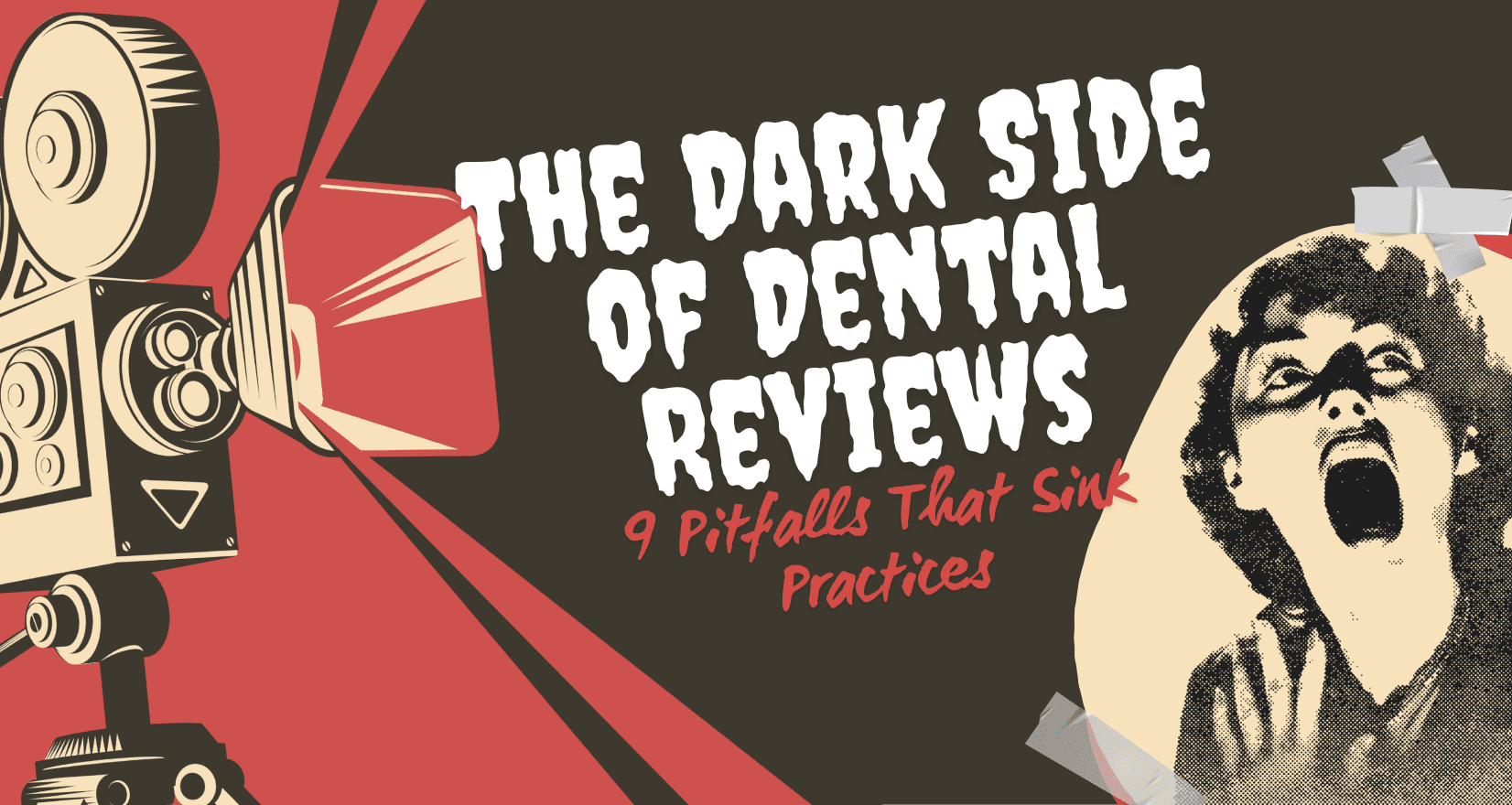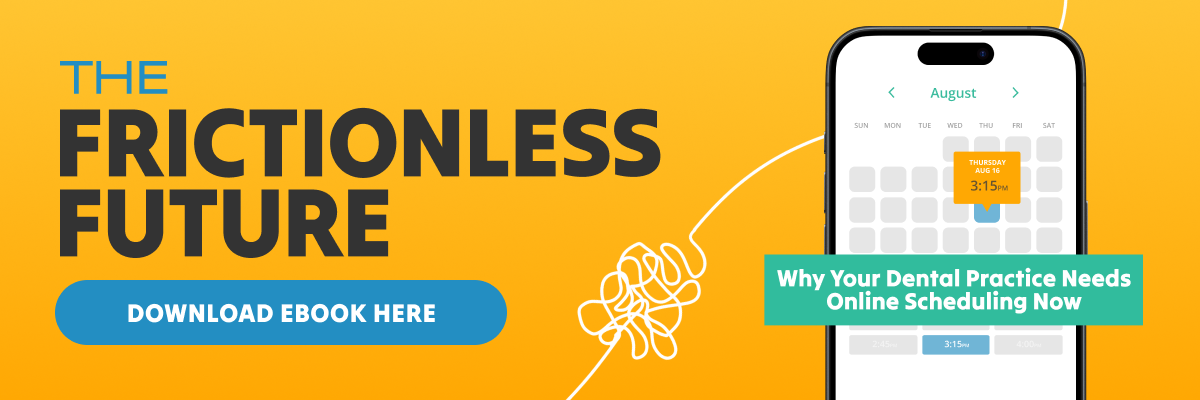
HIPAA Violations, Fake Feedback, and Other Dental Review Mistakes That Could Come Back to Bite You
Picture it: a quiet dental office after hours. The lights flicker. Somewhere in the dark corner of your Google Business Profile, a handful of neglected reviews begin to stir. They’re old. Forgotten. Half-rotted.
Before you know it—BAM—your online reputation is starring in its own low-budget horror movie. Boo! SpOoOoKy!!!
Welcome to the dark side of dental reviews, where innocent mistakes turn into marketing monsters. Maybe a fake review sneaks in like a vampire asking to be invited inside to use your bathroom. Maybe your staff makes a well-meaning reply that accidentally awakens the terrifying spirit of HIPAA. Or maybe your glowing reviews just… sit there. Like zombies. Not really alive, not really doing anything. Throw them some brains, doc, come on.
Every B horror movie starts with someone doing something well-intentioned but deeply, bafflingly unwise, like splitting up to “cover more ground.” (What ground, Sarah? What ground could you possibly need to cover? Just GO HOME.)
We’re here to save you and Sarah from becoming the next dental SEO cautionary tale audiences watch through their fingers in a dark movie theater.
In this guide, we’ll expose the most common review nightmares that can haunt your Google rankings, your reputation, and your peace of mind, and show you exactly how to keep them from crawling out of the crypt.
Grab your flashlight, a silver stake, (and maybe your bravest and most logically-minded office manager). It’s time to see if you can survive the dark side of dental reviews.
(And no, I did not plan to publish this on Halloween and then get distracted watching B horror movie clips on YouTube, why do you ask?)
Table of Contents
- Pitfall #1: Incentivizing Patients for Reviews
- Pitfall #2: The HIPAA Horror Story
- Pitfall #3: Mishandling Negative Reviews
- Pitfall #4: Fake Reviews
- Pitfall #5: The “Set It and Forget It” Trap
- Pitfall #6: Ignoring Reviews
- Pitfall #7: The “Front Desk Only” Myth
- Pitfall #8: Ignoring Multi-Location Review Balance
- Pitfall #9: The “Collect and Forget” Mistake
- You Survived the Dark Side (and Your Reputation Lived to Tell the Tale)
- FAQ
Pitfall #1: Incentivizing Patients for Reviews

Problem:
Ever heard of The Monkey’s Paw? You know, the old be-careful-what-you-wish-for, “Hey pal, go ahead and whisper your deepest desire to this suspicious and definitely-not-cursed object, I promise you won’t suffer ironic, unintended negative consequences as a result!” thing.
Somewhere deep in the swamp of online marketing myths, there still lurks the idea that you can trade a free whitening, gift card, or raffle ticket for a five-star review. It sounds harmless. Just a little wish on a totally innocent dismembered and mummified monkey hand. (The 1900s were a wild time for horror, guys.)
Unfortunately, that cute lil‘ taxidermied limb violates Google’s review policy and can hex your entire profile. Reviews disappear overnight, rankings drop, and suddenly you’re shouting into the digital void, wondering what went wrong, plus it turns out that the ten million dollars you wished for is stolen money and now you’re a wanted felon. GREAT.
Why It’s a Pitfall:
Offering incentives to patients for reviews is considered “review gating” or “compensated feedback.” Google’s not a fan. Neither are the dental boards or the FTC. When those offers are discovered, they can lead to removed reviews. Or worse, a suspended listing. Cue the scary violin musical sting.
Listen. If you ever find an ancient book full of curses in an abandoned cabin that’s labeled “GOOGLE REVIEW VIOLATIONS: DO NOT TOUCH” you should just walk away, alright?
Fix:
Reward your team, not your patients. Motivation is powerful when it’s internal. Programs like My Social Practice and TeamCare’s automated review incentive system pay team members small bonuses for every authentic review that comes in, encouraging them to ask confidently and consistently without crossing any ethical or compliance lines.
That way, your reviews grow naturally, your staff stays energized, and no one accidentally summons a demon.
Pitfall #2: The HIPAA Horror Story

Problem:
It starts innocently enough. A patient leaves a glowing review:
“Dr. Morgan fixed my chipped tooth and made it look perfect!”
You’re thrilled! You hit “Reply” and type, “We’re so glad you loved your bonding treatment, Sally!”
…and suddenly you’ve just confirmed that Sally is a patient and discussed her treatment publicly. Oopsie. (Please imagine a dramatic thunderclap.)
Why It’s a Pitfall:
Even the kindest, most well-meaning review response can violate HIPAA if it confirms someone’s patient status or references their treatment. That’s a major no-no, not just legally, but reputationally. Patients lose trust fast when privacy feels compromised, and regulators don’t share your sense of humor, which sucks because you and I both know that you are very funny.
Think of it like every horror flick where someone reads aloud from the cursed book after saying, “It’s probably fine.”
Spoiler: it’s never fine.
Fix:
Keep your replies friendly but neutral. You can thank reviewers without revealing anything specific.
- ❌ “Glad we could help with your root canal, Bob Smith, age 32!”
- ✅ “We’re so happy you had a great experience with our team!”
Pro tip: write like a customer-service professional, not a medical record. Short, gracious, and compliant is the safest way to keep your practice out of the HIPAA haunted house.
Pitfall #3: Mishandling Negative Reviews

Problem:
Every dental office eventually meets the One-Star Monster. It lurks in the shadows of your Google profile, muttering things like “Worst experience ever!” or “They wouldn’t give me a free cleaning!” or “Very few brains to eat, would not recommend.”
Your first instinct might be to grab your keyboard and go full Van Helsing. You’re ready to defend your reputation, explain the situation, maybe even sprinkle in some ALL CAPS JUSTICE.
Don’t. Step. Closer.
Why It’s a Pitfall:
Arguing online never ends well. Engaging defensively turns one bad review into a full-blown public drama, and that can scare off far more patients than the original complaint ever would. Ignoring it completely isn’t great either; silence looks like guilt.
Negative reviews can be tamed if handled wisely.
Fix:
Respond fast, stay calm, and keep it professional.
- Acknowledge the feedback without confirming treatment details.
- Apologize for their experience in general terms.
- Redirect the conversation offline.
Example:
“We’re sorry to hear you had a less-than-ideal experience. We take feedback seriously and would love to speak with you directly to make it right. Please contact our office manager at [phone/email].”
Handled correctly, even a one-star horror story can turn into a credibility win. Patients notice when you stay cool under pressure. It’s the equivalent of calmly karate-chopping the monster to death instead of screaming and tripping over a chair and it makes you look really cool and badass.
Pitfall #4: Fake Reviews

Problem:
In every classic horror movie, there’s that one shortcut. The one that will definitely lead the group of 25-year-old teenagers to the cabin in the woods way faster, so just ignore the spooky trees and blood spatter and signs saying, “Beware of violent death.”
In the world of dental marketing, that ill-fated shortcut takes the form of fake reviews. They’re easy to spot. Mysteriously enthusiastic “patients” with weirdly perfect but stilted grammar, identical five-star phrasing, and profile pictures that look suspiciously like stock photos named “Happy Person 4.jpg.”
Why It’s a Pitfall:
Fake reviews might give your profile a temporary boost, but they’re the dental SEO version of the haunted woods where your car gets a flat tire, thanks Chad, cool shortcut, bro. Google’s algorithms are frighteningly good at spotting patterns of suspicious activity—same IP addresses, identical wording, or sudden review spikes—and can wipe out your entire review section overnight. Plus, real patients can smell something off. They have much more common sense than Chad the quarterback.
Fix:
Authenticity always wins. Instead of faking feedback, make it easy for real patients to share real stories. A consistent, legitimate review flow looks natural to both Google and humans.
Pitfall #5: The “Set It and Forget It” Trap

Problem:
You launch your big review push. The team’s excited. The posters are up. Reviews start pouring in. And then… silence.
Weeks pass. Months. Your once-bustling Google profile becomes a ghost town. The reviews are still there, sure, but they’re old, stale, and kind of undead. Not really alive, not really helping, the mournful whisper in the proverbial Victorian mansion of your reviews section. So sad.
Why It’s a Pitfall:
Google loves freshness. Regular, recent reviews signal that your practice is active, relevant, and trusted right now in the land of the living. When your last review is from the pre-pandemic era, both the algorithm and potential patients start to wonder if your office still exists or if it’s now a haunted dental museum. Which is sort of a cool setting for a ghost-hunting tv show, but I digress.
Worse, inconsistent review collection creates spikes and gaps that look unnatural to search engines. A single “burst” of reviews followed by months of inactivity can hurt your local SEO momentum.
Fix:
Keep your review strategy alive. Build consistency into your system instead of relying on one-off pushes. Encourage staff to ask for reviews every day, not just during campaign season. Don’t be like the tragic figure of Dr. Victor Frankenstein, who created life and then abandoned it like a total jerk.
Automated tools like our review incentive program make it easy. Your team stays motivated, reviews come in steadily, rewards flow automatically, and your Google profile stays fresh and doesn’t massacre the townsfolk in a fit of existential rage.
Pitfall #6: Ignoring Reviews

Problem:
You’ve got dozens—maybe hundreds—of patient reviews. But when someone scrolls through your Google listing, there’s only eerie silence. No replies, no engagement, just a long, echoing hallway of unanswered praise.
It’s quiet. Too quiet.
You haven’t been engaging with all of those shiny new reviews, have you? Tsk tsk.
Why It’s a Pitfall:
When you don’t respond to reviews, you’re sending a silent message to both Google and potential patients: “No one’s home.”
Google favors active engagement. Replying regularly signals that your business is attentive and trustworthy, boosting both visibility and click-through rates. And patients want to see you care. A kind, professional reply shows gratitude, reinforces your personality, and turns happy patients into loyal ones.
Without responses, your review section starts to look like an abandoned town where even the tumbleweeds gave up and went home.
Fix:
Make replying part of your weekly routine. Thank every positive reviewer, and respond calmly and courteously to negative ones (without diving into HIPAA quicksand).
Even a simple “We’re so glad you had a great experience!” keeps your listing alive and thriving in Google’s eyes. You don’t have to write essays, just show up.
Pitfall #7: The “Front Desk Only” Myth

Problem:
You know the scene. A creaky door, a mysterious sound, and one lone character says, “I’ll go check it out.” That’s what happens when your front desk team is solely responsible for asking patients for reviews.
We love the front desk around here. Truly, they probably would be able to figure out how to drive a stake into a vampire’s heart while answering emails. Here’s the thing, though. They’re brave, they mean well, but they’re outnumbered and overworked so quit making them go into the creepy cellar alone. Before long, they stop asking altogether, and your once-promising review campaign vanishes into the fog.
Why It’s a Pitfall:
When review collection rests on one person or one role, it becomes inconsistent. The front desk might forget when the phones are ringing off the hook, and your hygienists or assistants—who just spent 15 minutes with a five-year-old who can’t decide which toothbrush color he wants—miss the chance to ask while the good vibes are fresh.
Fix:
Turn your whole team into a squad of review hunters.
Empower everyone—hygienists, assistants, treatment coordinators, suspiciously vampiric dental professionals—to make the ask when it feels natural. Patients respond best to personal, genuine moments.
Enjoy this unrelated Instagram Reel of Dr. Vlad the Vampire Dentist.
And to keep it organized (without the chaos of tracking who earned what on a sticky note), use an automated system. You know, like a really cool and awesome one that connects each review to the right team member and rewards them automatically. Wow, that would be so rad, I bet only a very amazing dental marketing company would have a helpful product like that.
Empower everyone—hygienists, assistants, treatment coordinators, suspiciously vampiric dental professionals—to make the ask when it feels natural. Patients respond best to personal, genuine moments.
Pitfall #8: Ignoring Multi-Location Review Balance

Problem:
It’s alive!
Unfortunately, no one knows.
You’ve built a thriving multi-location dental brand, complete with brand-consistent business listings and shiny matching signage. But there’s a problem. One location has hundreds of glowing reviews while the others look like they were abandoned.
Patients searching Google Maps see one superstar office and two that appear, well, undead.
Why It’s a Pitfall:
Google treats each location as its own entity. When your reviews aren’t evenly distributed, your visibility and credibility take a hit. Even loyal patients may assume the low-review locations are new, struggling, or (worst of all) closed.
Plus, uneven engagement confuses Google’s local algorithm. It doesn’t know which profile to trust, so all your locations may rank lower.
Fix:
Each location should have an active, consistent flow of authentic reviews. Make sure every team knows their review goals, track results individually, and share success stories across locations to keep morale (and motivation) high.
Pitfall #9: The “Collect and Forget” Mistake

Problem:
You’ve done it! You’re out of the woods and back home, safe and sound and un-murdered by a freak in a hockey mask, with a hefty haul of Google reviews to show for it.
And then… nothing. They just sit there. Motionless. Gathering digital dust on your profile.
Those once-powerful reviews become the walking dead. Technically they’re still around, but not doing anything to help your dental marketing come alive.
Why It’s a Pitfall:
Your reviews are more than SEO signals; they’re free, authentic marketing content. When you don’t reuse them, you miss huge opportunities to reinforce your brand voice, highlight your best services, and feed search algorithms the juicy keyword context they crave.
Google’s AI Overviews and other AI search tools increasingly pull phrasing directly from reviews to determine relevance. If you’ve got reviews that mention “Invisalign,” “dental implants,” “kid-friendly dentist,” or “gentle hygienist,” then you’ve got a silver bullet for local SEO. But only if you actually use them.
Fix:
Don’t let your reviews rot—reanimate them! Muahahaha!
Here’s how to bring them back to life:
- On Social Media: Turn 5-star reviews into branded quote graphics or short testimonial reels.
- On Your Website: Embed recent Google reviews on your homepage and service pages. Match reviews to relevant keywords (e.g., implant reviews on your implant page).
- In Blog Posts or Email Campaigns: Use real patient language to strengthen conversational SEO and local relevance.
The more places your reviews live, the more they reinforce your reputation and your rankings. Because nothing’s scarier than wasted potential. That’s a B movie that would actually give me nightmares.
You Survived the Dark Side (and Your Reputation Lived to Tell the Tale)
Congratulations, you survived! You faced the HIPAA ghosts, dodged the fake-review curse, escaped the quicksand of inconsistency, and learned how to reanimate your forgotten reviews all without becoming a pretentious metaphor for society or whatever indie zombie films are doing these days.
Your dental practice’s reputation is no longer a doomed horror plot, but a success story with excellent lighting and a killer soundtrack.
The moral of this story is that online reviews don’t have to be scary. When you have the right system in place that keeps your team motivated, your reviews consistent, and your process compliant, then managing your reputation becomes less Night of the Living Dead and more Shrek 2. (Shrek 2 is an underrated banger, FYI.)
So cue the triumphant music. Roll the credits. And as the camera pans out over your thriving, five-star practice, remember:
In the battle of good vs. evil (and by evil, we mean inconsistent review management), you’ve already survived the dark side.
Frequently Asked Questions
Can dental offices offer incentives for patients to leave Google reviews?
No. Offering discounts, gifts, or other rewards to patients in exchange for reviews violates Google’s policies and can result in removed reviews or a suspended profile. Instead, dental practices can motivate their team members to ask for reviews through internal incentive programs. Rewarding staff — not patients — keeps your review strategy compliant, ethical, and effective.
How should dental practices respond to Google reviews without violating HIPAA?
When responding to reviews, never confirm that someone is a patient or discuss any details about their treatment. Keep your reply general, positive, and professional. For example, instead of saying, “We’re glad your crown turned out great,” use a neutral response such as, “We’re so happy you had a great experience with our team.” This approach protects patient privacy while still showing gratitude and engagement.
How often should a dental practice get new Google reviews?
Consistency matters more than volume. Aim for a steady stream of new reviews each month rather than large bursts all at once. Regular, recent feedback signals to Google that your practice is active and trusted right now, which can help improve local SEO rankings. Automated systems like review incentive programs make it easy to maintain that steady pace without extra workload.
About the Author: Megan Nielsen is an SEO strategist and the Grand Overlord of copywriting at My Social Practice. My Social Practice is a dental marketing company that offers a full suite of dental marketing services to thousands of dental practices throughout the United States and Canada.












![[Byte Sized Podcast Ep. 20] The Review Doctor's Playbook: Why Your Practice Needs 1,000+ Google Reviews (And How to Get Them) - dental review - My Social Practice - Social Media Marketing for Dental & Dental Specialty Practices google reviews for dentists](https://mysocialpractice.com/wp-content/uploads/2025/11/byte-sized_ep20-100x100.png)
